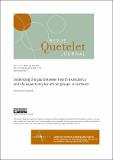Evidencing the gap between health expectancy and life expectancy for ethnic groups in Scotland
Abstract
Background Recent evidence has shown that ethnic minorities live longer than the majority population in Scotland. This mortality advantage in ethnic minorities is not unique to Scotland. However, whether morbidity patterns by ethnicity align with mortality patterns by ethnicity is unknown. Thus, this study explores ethnic differences in health expectancies (HE) in Scotland and contrasts HE with life expectancy (LE) findings. Methods The Scottish Health and Ethnicity Linkage study anonymously links the Scottish Census 2001 for 4.6 million people to mortality records. The Scottish Census 2001 collected two measures of self-assessed health, self-declared ethnicity, age, and sex. Utilising the life tables used to calculate life expectancy by ethnicity and sex in Scotland, the Sullivan method was employed to calculate two measures of health expectancy (healthy life expectancy and disability-free life expectancy) by ethnicity and sex. 95% confidence intervals were calculated to detect significant differences compared to the majority White Scottish population, taken as reference. Results Longer health expectancies were found in males and females of Other White British, Other White, and Chinese origins as well as in Indian males compared to White Scottish populations. Any Mixed Background and Pakistani populations had the shortest healthy life expectancies. Patterns of health expectancy by ethnicity mostly aligned with patterns of life expectancy by ethnicity with the clear exception of the Pakistani population who showed among the longest life expectancies with the shortest health expectancies. Contrasting HE with LE findings, the number of years in an unhealthy state was greater in females than in males for each ethnic group. In relation to ethnicity, Pakistani and Indian populations had the highest number of years in an unhealthy state in Scotland. Pakistani females showed the strong-est disadvantage in this respect. Conclusion Pakistani populations had the shortest health expectancies contrasting with the longest life expectancies in Scotland. Future research should aim to understand why such a discrepancy occurs while policy makers ensure that fair and adapt-ed care is provided to offer better quality of life for the most vulnerable.
Citation
Cezard , G I 2020 , ' Evidencing the gap between health expectancy and life expectancy for ethnic groups in Scotland ' , Revue Quetelet/Quetelet Journal , vol. 7 , no. 1 , pp. 135-162 . https://doi.org/10.14428/rqj2019.07.01.05
Publication
Revue Quetelet/Quetelet Journal
Status
Peer reviewed
ISSN
2593-9157Type
Journal article
Collections
Items in the St Andrews Research Repository are protected by copyright, with all rights reserved, unless otherwise indicated.

